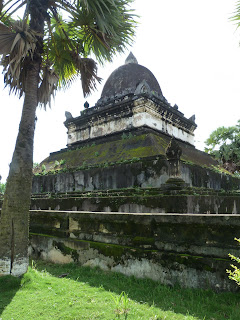After a brief detour through Khao Yai national park in northern Thailand (selection of photos on Facebook), I arrived in Vientiane, Laos. I thought Phnom Penh was tiny, but this capital managed to be even smaller: a few temples, some apartments and embassies, with restaurants and bars filling the spaces in between. Laos really struggled after independence from France and the end of its constitutional monarchy around 35 years ago. It didn't receive the same attention as given to its neighbours Vietnam and Cambodia, despite being a major theatre of the "secret war". Laos tops the charts for infant mortality in SE Asia and is one of the poorest countries in the region, but this was not immediately visible in any of the places I visited in my 10 days here. Laos has since tried to market itself as an eco-friendly tourist destination, luring travellers with promises of relatively untamed natural beauty and a more authentic Asian experience; like Cambodia and Vietnam before the touts and scams arrived. However, it was surprisingly expensive to eat, drink and sleep here - obviously not compared to the West, but almost 2 months into my trip I had started to get used to (almost) luxurious hotels for $10 and feasting on $1 meals.
3 days in Vientiane were enough to see the major sights: a few significant temples (my list of temples is growing longer and longer and they're all blurring together) and Patuxay Arch (an Arc-De-Triomphe-wannabe monument built from concrete that was donated by the US military under the assumption it would be used for a new airport runway).
 |
| Pha That Luang, Vientiane |
 |
| Patuxay Arch, Vientiane |
In the evening I hooked up with some Aussie gold miners and hit the town. Nightlife in Vientiane is, erm, interesting. There's only one club, which was more like a school disco, but lots of fun. Plenty of Dark Beer Lao (seriously... Best. Beer. Ever. I just know I'm going to end up paying £5 a bottle for it in a Soho bar), tequila shots and stories of unexploded ordnance, helicopter airlifts and unreported border flare-ups. I realised after I got back to my room that I had unintentionally broken the national midnight curfew - not sure what the punishment would have been but, based on the Lao legal system, would probably have been quite strict (as an aside I'm told that in the history of Lao legal system, once charged nobody has ever been acquitted - defence lawyers only act to reduce the sentence handed down, not to argue that their client is not guilty).
 |
| Vang Vieng |
Eventually we made it to Luang Prabang, the old capital and arguably the cultural centre of Laos, with shed loads of temples in a relaxed riverside setting. After a day exploring the town's palace-cum-museum and some of the larger Wats I booked myself onto a cooking class - partly to learn a bit about Lao cuisine and partly to get some cheeky practice in before I take a similar course in Thailand with a friend that'll undoubtedly get competitive.
 After some live Saturday Premiership football (why does northern Laos get it and the UK doesn't?) and another good night out on Beer Lao I nursed a hangover to the airport for my early morning flight to Bangkok. Maybe the national beer is not such a good idea. On the way I watched lines of monks collecting alms from the locals on their way to the monasteries. It sounds so serene, a basic, traditional way of life but I did see two monks checking Facebook in an internet cafe the day before.
After some live Saturday Premiership football (why does northern Laos get it and the UK doesn't?) and another good night out on Beer Lao I nursed a hangover to the airport for my early morning flight to Bangkok. Maybe the national beer is not such a good idea. On the way I watched lines of monks collecting alms from the locals on their way to the monasteries. It sounds so serene, a basic, traditional way of life but I did see two monks checking Facebook in an internet cafe the day before.I wish I could have visited other places in Laos and got a little further off the beaten track, especially in the south of the country, but weather and time constraints made it difficult. Plus I was getting itchy about being away from the sea and very much looking forward to the diving I would do in Thailand.



















